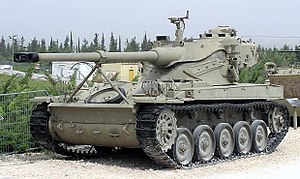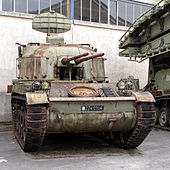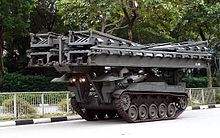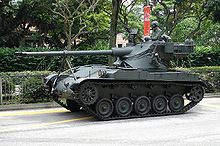AMX-13: Difference between revisions
m minor rewording/punctuation changes |
changed pic caption |
||
| Line 2: | Line 2: | ||
{{Infobox Weapon|name=AMX-13 |
{{Infobox Weapon|name=AMX-13 |
||
|image=[[File:AMX-13-.jpg|300px]] |
|image=[[File:AMX-13-.jpg|300px]] |
||
|caption= AMX-13 on display |
|caption= Israeli AMX-13 on display at "Yad La-Shiryon" armor museum |
||
|origin= [[France]] |
|origin= [[France]] |
||
|type=[[Light tank]] |
|type=[[Light tank]] |
||
Revision as of 06:48, 12 May 2016
This article needs additional citations for verification. (November 2008) |
| AMX-13 | |
|---|---|
 Israeli AMX-13 on display at "Yad La-Shiryon" armor museum | |
| Type | Light tank |
| Place of origin | France |
| Production history | |
| Designer | Atelier de Construction d'Issy-les-Moulineaux |
| Designed | 1946 |
| Manufacturer | Atelier de Construction Roanne |
| Produced | 1952–1987 |
| No. built | 7,700 (Total) 3,400 (Exported) 4,300 (Used in French military) |
| Specifications | |
| Mass | 13.7 t (30,000 lb) empty 14.5 t (32,000 lb) combat |
| Length | 4.88 m (16 ft 0 in) hull 6.36 m (20 ft 10 in) with gun |
| Width | 2.51 m (8 ft 3 in) |
| Height | 2.35 m (7 ft 9 in) |
| Crew | 3 (Commander, gunner and driver) |
| Armour | 10–40 mm (0.39–1.57 in) |
Main armament | 75 mm (or 90 mm or 105 mm) with 32 Rounds |
Secondary armament | 7.5 mm (or 7.62 mm) coaxial MG with 3,600 Rounds, 7.62 mm AA MG (optional), 2×2 smoke grenade dischargers |
| Engine | SOFAM Model 8Gxb 8-cyl. water-cooled petrol 250 hp (190 kW) |
| Power/weight | 15 hp/tonne |
| Suspension | Torsion bar suspension |
Operational range | 400 km (250 mi) |
| Maximum speed | 60 km/h (37 mph) |
The AMX-13 is a French light tank produced from 1953 to 1985. It served with the French Army, as the Char 13t-75 Modèle 51, and was exported to more than 25 other nations. Named after its initial weight of 13 tonnes, and featuring a tough and reliable chassis,[1] it was fitted with an oscillating turret built by GIAT Industries (now Nexter) with revolver type magazines, which were also used on the Austrian SK-105 Kürassier.[1] Including prototypes and export versions, there are over a hundred variants including self-propelled guns, anti-aircraft systems, APCs, and ATGM versions. Total production of the AMX-13 family is approximately 7,700 units, around 3,400 of which were exported.
History
The tank was designed at the Atelier de Construction d'Issy-les-Moulineaux (AMX) in 1946 to meet a requirement for an air-portable vehicle to support paratroopers. The first prototype ran from 1948. The compact chassis had torsion bar suspension with five road-wheels and two return rollers; the engine runs the length of the tank on the right side, with the driver on the left. It features an uncommon two-part oscillating turret, where the gun is fixed to the turret and the entire upper turret changes elevation. The turret is set to the rear of the vehicle and holds the commander and gunner. The original 75 mm gun was loaded by an automatic loading system fed by two six-round magazines located in on either side of the automatic loader in the turret's bustle. The 12 rounds available in the drum magazines meant that the crew could engage targets quickly; however, once those rounds were expended, the vehicle had to retreat to cover and the crew had to reload shells from outside the vehicle.
Production began at ARE (Atelier de Construction Roanne) in 1952, with the first tanks delivered the following year. In 1964, production was transferred to Creusot-Loire at Chalon-sur-Saône, as ARE switched to the production of the AMX 30 MBT, and the numbers produced declined significantly.
From 1966, the 75mm high-velocity gun was replaced by a 90 mm (the AMX-13/90) medium velocity gun firing more effective HEAT ammunition, with the French upgrading all existing base models to this specification. By the early 1970s, export models were available with an even more potent 105 mm gun. Although there were many variants on the turret, the basic chassis was almost unchanged until 1985, when changes including a new diesel engine, fully automatic transmission and new hydropneumatic suspension were introduced.
Production halted with the Model 1987. After sales support and upgrades are still offered through GIAT Industries (now Nexter).
The AMX-13 tank was phased out of service with the French Army in the 1980s. Current French armoured vehicles with a similar role are the ERC 90 Sagaie and the AMX 10 RC.
Additional characteristics

- Ground clearance: 370 mm (15 in)
- Fording: 600 mm (24 in)
- Vertical obstacle 650 mm (26 in)
- Trench: 1.6 m (5 ft 3 in)
- Gradient 60%
- Side slope: 60%
- NBC system: None
- Night vision: Optional
AMX13 in French army
During the Suez campaign, the French army used two sections of 2nd Foreign Cavalry Regiment AMX-13 tanks in Port Fouad . The AMX-13 saw limited action in the war of Algeria, due to the absence of opposition and the rough nature of the Algerian countryside from where the guerrillas operated.
AMX13 in Dominican republic
Two AMX 13 were destroyed by USMC M50 Ontos during the U.S. invasion of the Dominican Republic in 1965.
AMX13 in Sinai Campaign
The AMX13 was Israel’s first modern tank, purchased at a time that only France was willing to openly sell arms to Israel. By 1956, Israel had received 180 AMX-13 light tanks, as part of an agreement to reinforce Israel and maintain the balance after the Egyptian-Czechoslovak arms agreement. Due to the lack of tanks, the IDF used them as main battle tanks, equipping a tank battalion in the 7th Armored Brigade. Reconnaissance units did not use AMX13s and remained exclusively equipped with jeeps.
The 7th Armored Brigade advanced into the Sinai and its reconnaissance company played a decisive role on 30 October 1956 at Abu Ageila pass, in the central Sinai sector. The company managed to maneuver and discover that the pass was held only by a small force of Egyptian engineers, who fled when the Israelis arrived. The company secured the pass, allowing the 7th Armored brigade to pass through and surround the Egyptians.
AMX13 tanks in Six Day War
By 1967, Israel had acquired about 400 AMX-13s; and three AMX-13 battalions fought actively on all fronts.
- One tank battalion with AMX-13 tanks moved south in Western Bank through Taluzi and Tubas, and occupied Nablus.
- The second tank battalion captured the strongpoints protecting the Gaza Strip and the coastal road in the north of the Sinai Peninsula.
- The third battalion assaulted the Golan Heights.
One of the IDF’s lessons from the 1967 battles was that AMX-13 tank was too lightly armored and gunned for both a main battle and a reconnaissance role, but the under-equipped Israelis had little choice. The AMX-13 took heavy losses at places like Rafah Junction and Jiradi, and the tank was subsequently completely phased out of the IDF inventory, being sold to Singapore.
AMX13 tanks in Indo-Pakistani War
The offensive of Pakistan's 1st Armored Division (220 M48 Patton tanks and 44 M24 Chaffee light tanks) was blunted at the Battle of Assal Uttar on September 10th 1965. Pakistani forces were opposed by three Indian armored regiments: Deccan Horse (45 Sherman tanks), 3 Cavalry (45 Centurion tanks) and 8 Cavalry (45 AMX-13 tanks). The Indian regiments withdrew but rearranged their tanks into a U shaped formation around the town of Asal Uttar. The tall sugarcane grass allowed the Indian tanks to remain hidden and allowed them to be much closer to the Pakistani tanks, besides India flooded the fields to immobilize the Pakistani tanks in the mud. About 100 Pakistani tanks were either destroyed or captured, while the Indians lost only 10 tanks during this battle.
AMX13 in Lebanon
Lebanese AMX-13s saw extensive service during the Lebanese civil war against Hezbollah in the hand of various armed groups in and outside Beirut.
AMX13 in Morocco
Morocco used some AMX13 in Western Sahara, at least four were captured by Polisario guerrillas. Morocco decided to supplement its AMX-13s with the more advanced Austrian SK-105 Kürassier.
Prototypes
- Char AMX-13 (2A)
- Prototype with 4 roadwheels and trailing idler
- Char AMX-13 (2B)
- Prototype with 5 roadwheels and raised idler
- Char AMX-13 (2C)
- Prototype with FL-10 turret and two support rollers
- Char AMX-13 (2D)
- Prototype with 4 support rollers
- Char AMX-13 (2E)
- Prototype with 3 support rollers and 90 mm gun
- Char AMX-13 (2F)
- Prototype with 2 support rollers and, later, a thermal sleeve
Other prototypes
- AMX-13 avec tourelle
- A14 Fitted with a German HS-30 turret
- AMX-13
- Fitted with a 105 mm howitzer barrel
- AMX-13/75 (AMX-13e)
- Experimental variant with a short-barreled 75 mm in FL-11 turret
- Char AMX-13 avec Canon 57 L/100
- Prototype with a special gun
- AMX-13 Twin 20 mm in a welded turret without a bustle
- Char 48FCM
- AKA Char 12T FCM, DCA de Quatre Canons de 20 mm—4 x 20 mm cannon in an FL-4 turret
- DCA de 40 mm
- AKA Char 13T DCA a 40 mm Bofors L/70 gun in a large faceted turret
- AMX-13 GTI
- Improved suspension by Krauss-Maffei
- AMX-13 THS
- Prototype fitted with hydrostatic transmission
- AMX-13
- Fitted with Rapace 14 MBRL
- AMX-13 HOT
- Fitted with HOT ATGM launchers
Production variants




- AMX-13
- Some initial vehicles were fitted with the turret of the M24 Chaffee
- AMX-13 [DTT]
- Initial vehicles with the turret of the M24 Chaffee converted into a driver training tank. Gun removed.
- AMX-13/75 Modèle 51
- High-velocity 75 mm Gun in FL-11 turret as installed in Panhard EBR armoured car, with two top rollers
- AMX-13/75 Modèle 51
- High-velocity 75 mm Gun in FL-11 turret, with four top rollers and revised stowage
- AMX-13 T75 (Char Lance SS-11)
- Fitted with SS.11 ATGM launchers
- AMX-13 T75 avec TCA
- Fitted with an electronic guidance system for the missiles
- AMX-13/90 Modèle 52
- FL-10 turret refitted with the F3 90 mm gun
- AMX-13/90 LRF
- Fitted with a laser rangefinder
- AMX-13/105 Modèle 58
- Fitted with a 105mm Gun in an FL-12 turret (used by the Argentine Army and the Netherlands)
- AMX-13/105
- Upgraded export version of the Modele 58 with a thermal sleeve and a revised hull front
- AMX-13 Model 1987
- Late production version
- AMX-13 DCA 30
- SPAAG version with a retractable radar fitted; 60 were produced beginning in 1969.[2]
- AMX-13 [Training Tank]
- AMX-13 with the turret removed; used for driver training
- AMX-13 Modèle 55 (AMX-D)
- Recovery version
- AMX-13 PDP (Poseur De Pont) Modèle 51
- Scissors-type bridgelayer
Modernisation packages
- Cockerill 90 mm Regunning Packaging: 90 mm upgunning package
- Giat Industries upgrade with a Baudouin 6F 11 SRY diesel engine and an upgraded turret
- Giat Industries Add-on Armour package installed on turret front/sides and glacis plate
- NIMDA Upgrade Package: Israeli retrofit package
- INDRA Amazon Fire Control System upgrade with thermal imaging and a laser rangefinder
National
- Netherlands
- AMX-13/FL-12 [Modernised] by the Netherlands: Fitted with a searchlight and FN MAG machine-guns
- AMX-13/FL-15 Dutch FL-12 version refitted with an FL-15 Turret
- Singapore

- AMX-13S Rebuild of standard AMX-13/75 Modèle 51 (FL-11) by Singapore prior to SM-1 upgrade.
- AMX-13SM1 (Singapore Modernised 1): Singaporean upgrade with modern communications, a new diesel engine replacing the original petrol engine, improved transmissions/suspensions system, laser range-finder and night vision elbow upgrade by ST Kinetics.[3] The 75 mm main gun remain unchanged.[3]
- Switzerland
- Leichter Panzer 51 Swiss Army version
- Peru
- AMX-13PA5 Escorpion Proposed upgrade for a standard AMX-13/105 by the Peruvian designer Sergio Casanave, fitted with modern communications and 4 9M14-2T missiles.
- AMX-13PA8 Escorpion-2 equipped with Dante fire-control system (a ballistic computer/laser range-finder/night vision/CCTV system), four Ukrainian laser-guided Barrier R-2 antitank missiles and 7.62 mm and 12.7 mm machine-guns was also proposed.
- Venezuela
- AMX-13V CLI upgraded AMX-13/90 for Venezuelan Army
- AMX-13 [LAR-160] Venezuelan MLRS version armed with IMI LAR-160 mm. rockets
- AMX-13M51 Ráfaga Venezuelan Army's AA version armed with two 40 mm cannons mounted on an M-4E1 turret
APC
The AMX-13 was the basis of a family of APCs beginning with the AMX-VTT and culminating with the AMX-VCI. The APC chassis was itself the basis of a number of variants.
Self propelled howitzer
- 105 mm

- AMX Mk 61 (AMX-105A) Automoteur de 105 du AMX-13 en casemate: 105 mm casemate SP
- AMX Mk 61 (Netherlands) Dutch Army version with 30 calibre howitzer and Browning commander's MG
- AMX Mk 62 (AMX-105B) Prototype with 105 mm howitzer in a turret
- AMX Mk 63 (AMX-105B, AMX Mk F2) Prototype of Mk 62 with MG cupola fitted to turret
- 155 mm
- AMX Mk F3 (Obusier de 155 mm sur affut automoteur AMX-13 T, AMX-155) 155 mm SPH
Operators

Current operators
 Argentina - 24 AMX Mk F3 155 mm self-propelled howitzer version, to be replaced by 36 M109 howitzers.[4]
Argentina - 24 AMX Mk F3 155 mm self-propelled howitzer version, to be replaced by 36 M109 howitzers.[4] Cambodia - 12.
Cambodia - 12. Ivory Coast - 5.
Ivory Coast - 5. Djibouti - 60.
Djibouti - 60. Ecuador - 102.
Ecuador - 102. Indonesia - 250 (?).
Indonesia - 250 (?). Kuwait - Unknown number.
Kuwait - Unknown number. Mexico - 409 AMX-VCI.
Mexico - 409 AMX-VCI. Nepal - Unknown number.
Nepal - Unknown number. Peru - 210.
Peru - 210. Singapore - 350 AMX-13/SM1 (ex-IDF machines, locally upgraded and modernised, phasing out).
Singapore - 350 AMX-13/SM1 (ex-IDF machines, locally upgraded and modernised, phasing out). Venezuela - 36 AMX-13C.90.
Venezuela - 36 AMX-13C.90.
Former operators

 Algeria - Unknown number.
Algeria - Unknown number. Austria - Unknown number.
Austria - Unknown number. Argentina - 60 AMX-13/105 FL-12 received; currently in storage.[citation needed]
Argentina - 60 AMX-13/105 FL-12 received; currently in storage.[citation needed] Belgium - 555 built under licence, mostly APCs (305) and other variants based on the APC version.[5]
Belgium - 555 built under licence, mostly APCs (305) and other variants based on the APC version.[5] Chile - 12 AMX Mk F3 155 mm self-propelled howitzer version.
Chile - 12 AMX Mk F3 155 mm self-propelled howitzer version. Dominican Republic - 15.
Dominican Republic - 15. Egypt - Unknown number (Also bought its turret to upgrade the existing M4 Sherman).
Egypt - Unknown number (Also bought its turret to upgrade the existing M4 Sherman). El Salvador - 12 ordered, but no evidence that they were ever delivered.
El Salvador - 12 ordered, but no evidence that they were ever delivered. France - The AMX-13 tank was phased out of service with the French Army in the 1970s.
France - The AMX-13 tank was phased out of service with the French Army in the 1970s. Guatemala - 12.
Guatemala - 12. India - Indian Army used AMX-13 Tanks against Pakistan in the Indo-Pakistani War of 1965.
India - Indian Army used AMX-13 Tanks against Pakistan in the Indo-Pakistani War of 1965. Israel - Retired and sold to Singapore in 1969.
Israel - Retired and sold to Singapore in 1969. Lebanon - 35 in service with the Lebanese Army in 1976, passed on to the Kataeb Regulatory Forces militia, Tigers Militia (Lebanon), Amal Movement, Al-Mourabitoun, Army of Free Lebanon, Lebanese Arab Army, Lebanese Forces and South Lebanon Army.
Lebanon - 35 in service with the Lebanese Army in 1976, passed on to the Kataeb Regulatory Forces militia, Tigers Militia (Lebanon), Amal Movement, Al-Mourabitoun, Army of Free Lebanon, Lebanese Arab Army, Lebanese Forces and South Lebanon Army. Morocco - Replaced by SK-105 Kurassier.
Morocco - Replaced by SK-105 Kurassier. Netherlands - 131.
Netherlands - 131. Switzerland - 200 AMX-13 introduced as Light Tank 51 (Leichter Panzer 51) between 1952 and 1954. Served in light tank battalions till 1961 and then as recon vehicles with recon battalions till the last ones were phased out in 1980. Four howitzer variants purchased for trials in 1962-64; not introduced into service.[6]
Switzerland - 200 AMX-13 introduced as Light Tank 51 (Leichter Panzer 51) between 1952 and 1954. Served in light tank battalions till 1961 and then as recon vehicles with recon battalions till the last ones were phased out in 1980. Four howitzer variants purchased for trials in 1962-64; not introduced into service.[6] Tunisia - 55 AMX-13 75mm main gun light tank (no longer in service).
Tunisia - 55 AMX-13 75mm main gun light tank (no longer in service).
See also
References
- Notes
- ^ a b The Complete Guide to Tanks and Armoured Fighting Vehicles, ISBN 978-1-84681-110-4 [page needed]
- ^ Hogg, Ian (2000). Twentieth-Century Artillery. Barnes & Noble Books. p. 250. ISBN 978-0-7607-1994-7.
- ^ a b "Official AM-13SM1 Brochure" (PDF). Retrieved 2008-11-17.
- ^ Army of Argentine plans to purchase OTO-Melara MOD-56 light howitzers and M109 155mm howitzers - Armyrecognition.com, 21 December 2013
- ^ Belgian Tank Museum (Brussels).
- ^ Panzermuseum Thun, informational plaque, 2008.
- Bibliography
- Speilberger, Walter (1967). AMX.13. Armour in Profile. Profile Publications. Nº 12.
{{cite book}}: Invalid|ref=harv(help) - Lau, Peter (2006). The AMX-13 Light Tank. Vol. Volume 1: Chassis. Rock Publications.
{{cite book}}:|volume=has extra text (help); Invalid|ref=harv(help) - Lau, Peter (2007). The AMX-13 Light Tank. Vol. Volume 2: Turret. Rock Publications.
{{cite book}}:|volume=has extra text (help); Invalid|ref=harv(help)
